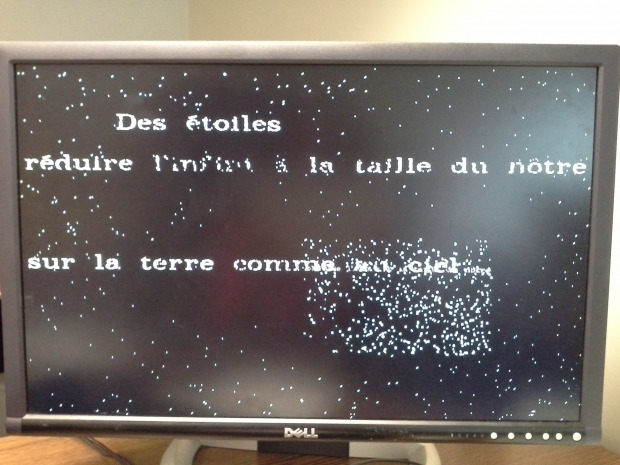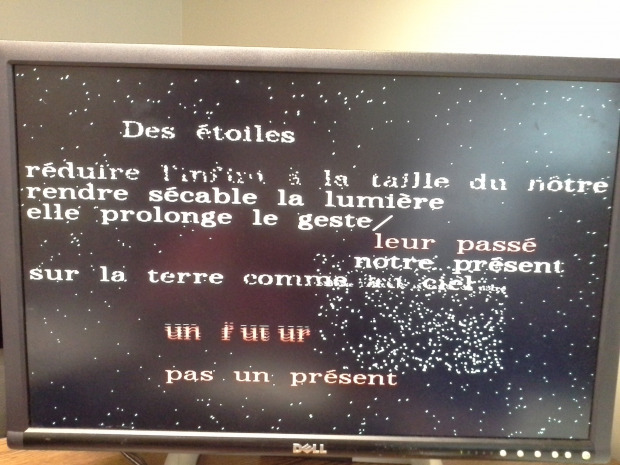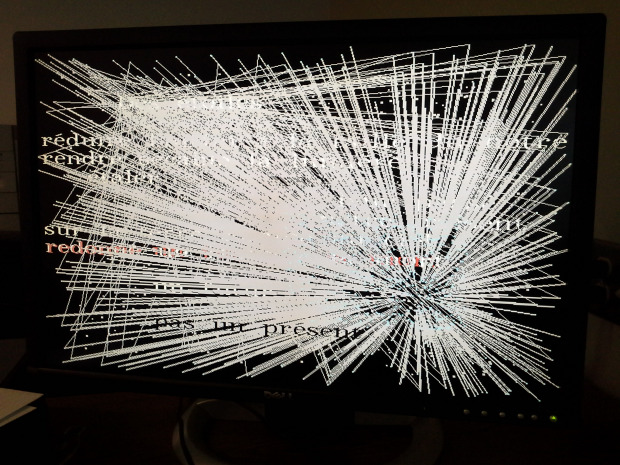En réponse à la lampe
“En Réponse à la lampe” was published in the journal "alire n°6" for the first time in 1992. In 1996, it was ported. This animated poem gives an important amount of possibilities for reading thanks to the apparition and the disappearance of the various bribes. The poem moves on a black screen and the text is mostly printed in white. The text is made of some stable elements in time, which allows the reader to memorize a small amount of verses at a time. Some other verses on the other hand, appear and disappear as they please anywhere on the screen, making it difficult to construct a meaning, because of the transitory aspect of the poem. An esthetic of frustration appears, because when verses appear, they fade right away. However, the transitory aspect of the text allows a temporal reading, based on the reader’s memory. The printed text seems to be the following: « Des étoiles réduire l’infini à la taille du nôtre rendre sécable la lumière elle prolonge le geste /leur passé notre présent sur la terre comme au ciel un futur pas un présent » The word that is mobile and appears furtively is “le futur” (“the future”), which appears as though it was blinking, as though it was passing on the screen. Several words and expressions are also chromatically accented (words become red), or blurry. These words have a temporal connotation, “leur passé” (“their past”), “redonne un futur à la mort” (“give another meaning to death”), “pas un présent” (“not a present”) and “un futur” (“a future”). Once all the verses are on the screen, and that we try to reconstitute a meaning, the words fade away and several beams burst on the screen, like light beams, like a white, monochrome prism of light. Then, the text “pas un présent” appears on top of these beams. The end of the poem seems to be a dedication and the signature of the author. The poem was dedicated to Patrick Burgaud, who also is an author of digital literature and kinetic poetry. Finally, the date, the title and the name of the author appear and the poem ends. Meditating on the nature of the animated poem, the speed of the transitory poem, of the temporal theme suggested by the bribes and the light suggested by the title, one could easily deduct that the poem is a reflection and an illustration of time passing, the brevity of time but also on the fact that we cannot grasp our future the word “futur” fades away and passes several times). This theme goes hand in hand with animated poetry, because the furtive aspect of the verses echoes the furtive aspect of life.
« En réponse à la lampe » a été publié dans le journal « alire n°6 » pour la première fois en 1992. En 1996, un portage informatique a été réalisé. Ce poème animé donne une possibilité importante de lectures grâce à l’apparition et la disparition de nombreuses bribes. Le poème bouge sur un écran noir, et le texte est pour la plupart imprimé en blanc. Le poème est composé de quelques éléments plutôt stables dans le temps, qui permettent au lecteur de pouvoir mémoriser un très petit nombre de vers, puis d’autres éléments ou vers apparaissent et disparaissent à leur guise, n’importe où à l’écran, rendant difficile de remédier à un sens quelconque, à cause de l’aspect transitoire du poème. Une esthétique de la frustration surgit de ce poème car, au moment où les vers apparaissent, ils s’estompent aussitôt. Cependant, l’aspect transitoire du texte permet une lecture temporelle, basée sur la mémoire du lecteur. Le poème imprimable semble être celui-ci : « Des étoiles réduire l’infini à la taille du nôtre rendre sécable la lumière elle prolonge le geste /leur passé notre présent sur la terre comme au ciel un futur pas un présent » Le mot qui est mobile et qui apparaît de façon furtive est « le futur » qui apparaît comme s’il clignotait, puis comme s’il défilait à l’écran. Plusieurs mots et expressions sont également doués d’une accentuation chromatique (les mots deviennent rouges) ou ont un effet de flou. Ces mots ont une connotation temporelle « leur passé », « redonne un futur à la mort », « pas un présent » et « un futur ». Une fois que l’on a à l’écran presque tous les vers, et que l’on tente de construire une signification, les mots s’estompent et plusieurs faisceaux éclatent à l’écran, tels des faisceaux de lumières, comme un prisme de lumière monochrome, blanc. Puis le texte « pas un présent » apparaît. La fin du poème semble être une dédicace et une signature de l’auteur. Le poème a été dédié à Patrick Burgaud, également auteur de littérature numérique et poésie cinétique. Puis la date, le titre et l’auteur du poème apparaissent, et le poème prend fin. En méditant sur la nature du poème animé, la vitesse du poème transitoire, du thème temporel suggéré par les bribes et de la lumière suggéré par le titre, nous pouvons déduire que ce poème est une réflexion et une illustration du passage du temps, sur la brièveté du temps qui passe mais aussi sur le fait que l’on ne puisse pas saisir notre futur (le mot futur s’estompe et défile à plusieurs reprises). Ce thème correspond donc bien avec la poésie animé, car l’aspect furtif des vers du poème fait écho avec l’aspect furtif de la vie.





